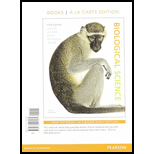
Concept explainers
What important role does lignin play in vascular plants?
a. It is the major component of the cuticle, which prevents plants from drying out.
b. It forms the outer layer of pollen grains.
c. It forms the tough, rigid cell walls of water-conducting cells.
d. It nourishes the embryo in seed plants.
Introduction:
The lignin is the polymer made of the monomers of monolignol. The polymers of the lignin are filled in the voids in the cell walls. The xylem is the tissue, which performs the function of the conduction of the water and dissolved minerals in the plant.
Answer to Problem 1TYK
Correct answer:
It makes rigid and tough cell walls of water-conducting cells.
Explanation of Solution
Explanation/justification for the correct answer:
Option (c) is given as forming of rigid and tough cells walls for water-conducting cells. The lignin is present in the xylem tissues. The hemicellulose is linked with the lignin by the covalent bonding to provide the strength to the vascular cell wall, which further provides strength to the vascular plants. Therefore, the lignin forms the rigid and tough cell walls of the vascular cells. Hence, the Option (c) is correct.
Explanation for incorrect answer:
Option (a) is given as a major component of the cuticle, which plays a role in preventing drying out of a plant. The plant organs, such as leaves and young shoots are covered with the thin layer of a waxy substance called the cuticle. The cuticle is composed of the cutin, which is hydrophobic in nature. The cutin is present instead of lignin in the cuticle. So, it is a wrong answer.
Option (b) is given as forming the outer layer of pollen grains. The outer layer of the pollen grain is called exine. The exine is made up of the substance sporopollenin. The sporopollenin is the chemically inert substance found in the pollen grain. The lignin is not present in the outer layer of the pollen grains. So, it is a wrong answer.
Option (d) is given as nourishment of embryo in the seed plants. The embryo is the developing tissue inside the seed of the plant. The embryo requires the nutrients for the further development. The necessary nutrients are provided by the endosperm. The main constituent of the endosperm is the starch. The endosperm surrounds the developing embryo. Therefore, the lignin does not provide the nourishment to the embryo cells.
Hence, the options (a), (b), and (d) are incorrect.
Lignin is responsible for providing strength to the plant by forming the tough and rigid cell wall. The cuticle is present on the surface of leaves and shoots that prevent drying out of a plant. Exine forms the outer layer of pollen grains and endosperm provide nourishment to the developing embryo.
Want to see more full solutions like this?
Chapter 28 Solutions
Biological Science, Books a la Carte Plus Mastering Biology with Pearson eText -- Access Card Package (6th Edition)
- Which of the following is the role of iron in plants? A. endosperm development and dehydrogenase activity B. photodestruction of chlorophyll and chloroplast structure C. energy transferring process for photosynthesis and respiration D. regulatory component of proteins and metabolites in roots and leavesarrow_forwardMitotic Cell division occurs in dogs, potato, zebra, and parrots cells. Which character will be absent in potato plants but present in dogs, zebra, and parrots cells? a. Root apical meristems are present where mitosis occurs. b. The resulting cells will contain exact numbers of chromosomes comparing parental cells. c. Star shaped Aster formation occurs around centrioles. d. Cell plate formation occurs.arrow_forwardIt is the hormone which is responsible for stem elongation. * a. Gibberellins b. Ethylene c. Cytokinin d. Abscisic acidarrow_forward
- Pollen grains in plants are produced in: A. roots B. leaves C. flower D. stemarrow_forwardPlants develop from stem cells called O A. blastocyst B. meristems C. embryonic stem cells D. adult stem cellsarrow_forwardWhat plant tissue has cells that are dead at maturity? a. Xylem c. Ground b. Phloem d. Dermalarrow_forward
- Which cells are responsible for the movement of photosynthates through a plant? a. tracheids, vessel elements b. tracheids, companion cells c. vessel elements, companion cells d. sieve-tube elements, companion cellsarrow_forwardPlant development is influenced by: A. quality of light only B. quality and quantity of light C. quality and duration of light D. quality, quantity and duration of lightarrow_forwardWhich of the following cell types is responsible for cavitation-induced spore dispersal in most ferns? A. stipe cells B. indusium cells C. oogonia cells D. annular cellsarrow_forward
- What adaptation do seed plants have in addition to the seed that is not found in seedless plants? a. gametophytes b. vascular tissue c. pollen d. chlorophyllarrow_forwardIf the VIN3 gene had a loss-of-function mutation, how do youthink that would affect the phenotypes of summer-annual andwinter-annual Arabidopsis plants?a. Neither type would flower.b. Both types would flower at the proper time.c. The summer type would flower, but the winter type wouldnot.d. The winter type would flower, but the summer type wouldnot.arrow_forwardWhich of the following statements is NOT true of the stems of vascular plants? a. Stems are composed of repeating segments, including nodes and internodes. b. Primary growth only occurs at the shoot apical meristem. c. Vascular tissues may be arranged on the outside of the stem or scattered throughout the stem. d. Stems can contain stomata.arrow_forward
 Biology (MindTap Course List)BiologyISBN:9781337392938Author:Eldra Solomon, Charles Martin, Diana W. Martin, Linda R. BergPublisher:Cengage Learning
Biology (MindTap Course List)BiologyISBN:9781337392938Author:Eldra Solomon, Charles Martin, Diana W. Martin, Linda R. BergPublisher:Cengage Learning Concepts of BiologyBiologyISBN:9781938168116Author:Samantha Fowler, Rebecca Roush, James WisePublisher:OpenStax College
Concepts of BiologyBiologyISBN:9781938168116Author:Samantha Fowler, Rebecca Roush, James WisePublisher:OpenStax College

